A Novel Integrated UWB Sensing and 8-Element MIMO Communication Cognitive Radio Antenna System
Abstract
:1. Introduction
2. Twenty-Five Port CR Integrated Antenna System
3. Design Process of the Sensing Antenna Linked with Port 1
4. Design Process of the Communication Antennas Linked with P2 to P9
5. Design Process of the Communication Antennas Linked with P10 to P17
6. Design Process of the Communication Antennas Linked with P18 to P24
7. Results and Discussions
8. Performance Analysis of the 25-port CR MIMO Antenna
9. Conclusions
Author Contributions
Funding
Institutional Review Board Statement
Informed Consent Statement
Data Availability Statement
Acknowledgments
Conflicts of Interest
References
- Riaz, S.; Zhao, X.; Geng, S. A Frequency Reconfigurable MIMO Antenna with Agile Feedline for Cognitive Radio Applications. Int. J. RF Microw. Comput. Aided Eng. 2019, 30, e22100. [Google Scholar]
- Hussain, R.; Raza, A.; Khan, M.U.; Shammim, A.; Sharawi, M.S. Miniaturized Frequency Reconfigurable Pentagonal MIMO Slot Antenna for Interweave CR Applications. Int. J. RF Microw. Comput. Aided Eng. 2019, 29, e21811. [Google Scholar] [CrossRef]
- Alam, T.; Thummaluru, S.R.; Chaudhary, R.K. Integration of MIMO and Cognitive Radio for Sub-6 GHz 5G Applications. IEEE Antennas Wirel. Propag. Lett. 2019, 18, 2021–2025. [Google Scholar] [CrossRef]
- Cheng, S.; Lin, K. A Reconfigurable Monopole MIMO Antenna with Wideband Sensing Capability for Cognitive Radio using Varactor Diodes. In Proceedings of the IEEE International Symposium on Antennas and Propagation & USNC/URSI National Radio Science Meeting, Vancouver, BC, Canada, 19–24 July 2015; pp. 2233–2234. [Google Scholar]
- Thummaluru, S.R.; Ameen, M.; Chaudhary, R.K. Four-Port MIMO Cognitive Radio System for Midband 5G Applications. IEEE Trans. Antennas Propag. 2019, 67, 5634–5645. [Google Scholar] [CrossRef]
- Zhao, X.; Riaz, S.; Geng, S. A Reconfigurable MIMO/UWB MIMO Antenna for Cognitive Radio Applications. IEEE Access 2019, 7, 46739–46747. [Google Scholar] [CrossRef]
- Hussain, R.; Sharawi, M.S. A Cognitive Radio Reconfigurable MIMO and Sensing Antenna System. IEEE Antennas Wirel. Propag. Lett. 2015, 14, 257–260. [Google Scholar] [CrossRef]
- Pahadsingh, S.; Sahu, S. Four Port MIMO Integrated Antenna System with DRA for Cognitive Radio Platforms. AEU-Int. J. Electron. Commun. 2018, 92, 98–110. [Google Scholar] [CrossRef]
- Hussain, R.; Khan, M.U.; Sharawi, M.S. An Integrated Dual MIMO Antenna System with Dual-Function GND-Plane Frequency Agile Antenna. IEEE Antennas Wirel. Propag. Lett. 2018, 17, 142–145. [Google Scholar] [CrossRef]
- Alam, T.; Thummaluru, S.R.; Chaudhary, R.K. Improved Multifunctional MIMO Cognitive Radio System for Integrated Interweave-Underlay Operations. IEEE Trans. Microw. Theory Tech. 2022, 70, 631–640. [Google Scholar] [CrossRef]
- Jain, P.; Saptarshi, G. A Reconfigurable Four-Port MIMO Antenna for Sub-6 GHz Applications. In Proceedings of the IEEE Wireless Antenna and Microwave Symposium (WAMS), Rourkela, India, 5–8 June 2022; pp. 1–5. [Google Scholar]
- Mansoul, A.; Mourad, N. Compact and Reconfigurable Multiband 2-Element MIMO Slot Antenna for Advanced Communication Systems. In Proceedings of the IEEE International Symposium on Antennas and Propagation and North American Radio Science Meeting, Montreal, QC, Canada, 5–10 July 2020; pp. 575–576. [Google Scholar]
- Hussain, R.; Sharawi, M.S. 4-Element Planar MIMO Reconfigurable Antenna System for Cognitive Radio Applications. In Proceedings of the IEEE International Symposium on Antennas and Propagation & USNC/URSI National Radio Science Meeting, Vancouver, BC, Canada, 19–24 July 2015; pp. 717–718. [Google Scholar]
- Hussain, R.; Sharawi, M.S.; Shamim, A. 4-Element Concentric Pentagonal Slot-Line-Based Ultra-Wide Tuning Frequency Reconfigurable MIMO Antenna System. IEEE Trans. Antennas Propag. 2018, 66, 4282–4287. [Google Scholar] [CrossRef]
- Chacko, B.P.; Augustin, G.; Denidni, A. Electronically Reconfigurable Uniplanar Antenna with Polarization Diversity for Cognitive Radio Applications. IEEE Antennas Wirel. Propag. Lett. 2015, 14, 213–216. [Google Scholar] [CrossRef]
- Hussain, R.; Sharawi, M.S.; Shamim, A. An Integrated Four-Element Slot-Based MIMO and a UWB Sensing Antenna System for CR Platforms. IEEE Trans. Antennas Propag. 2018, 66, 978–983. [Google Scholar] [CrossRef] [Green Version]
- Tawk, Y.; Constantine, J.; Christodoulou, C.G. Reconfigurable Filtennas and MIMO in Cognitive Radio Applications. IEEE Trans. Antennas Propag. 2014, 62, 1074–1083. [Google Scholar] [CrossRef]
- Islam, H.; Das, S.; Ali, T.; Bose, T.; Prakash, O.; Kumar, P. A Frequency Reconfigurable MIMO Antenna with Bandstop Filter Decoupling Network for Cognitive Communication. Sensors 2022, 22, 6937. [Google Scholar] [CrossRef]
- Hussain, R.; Sharawi, M.S. An Integrated Slot-Based Frequency-Agile and UWB Multifunction MIMO Antenna System. IEEE Antennas Wirel. Propag. Lett. 2019, 18, 2150–2154. [Google Scholar] [CrossRef]
- Nella, A.; Abhay, S.G. A survey on planar antenna designs for cognitive radio applications. Wirel. Pers. Commun. 2018, 98, 541–569. [Google Scholar] [CrossRef]
- Nella, A.; Abhay, S.G.; Vigneswaran, D. Cognitive radio paradigm and recent trends of antenna systems in the UWB 3.1–10.6 GHz. Wirel. Netw. 2020, 26, 3257–3274. [Google Scholar]
- Srikar, D.; Anuradha, S. Twelve Port MIMO Antenna with Polarisation Diversity for Cognitive Radio Applications. Electron. Lett. 2019, 55, 1165–1168. [Google Scholar] [CrossRef]
- Srikar, D.; Anuradha, S. A Compact Six Port Antenna for Better Spectrum Utilization Efficiency in Cognitive Radio Applications. Int. J. RF Microw. Comput. Aided Eng. 2020, 30, e22383. [Google Scholar] [CrossRef]
- Srikar, D.; Anuradha, S. A New Two-Element MIMO Antenna System for Cognitive Radio Applications. Circuit World 2022, 48, 111–125. [Google Scholar] [CrossRef]
- Nella, A.; Gandhi, A.S. A Five-Port Integrated UWB and Narrowband Antennas System Design for CR Applications. IEEE Trans. Antennas Propag. 2018, 66, 1669–1676. [Google Scholar] [CrossRef]
- Anvesh Kumar, N.; Gandhi, A.S. A Compact Novel Three-Port Integrated Wide and Narrow Band Antennas System for Cognitive Radio Applications. Int. J. Antennas Propag. 2016, 2016, 2829357. [Google Scholar]
- Nandi, S.; Mohan, A. CRLH Unit Cell Loaded Triband Compact MIMO Antenna for WLAN/WiMAX Applications. IEEE Antennas Wirel. Propag. Lett. 2017, 16, 1816–1819. [Google Scholar]
- Balaji, V.R.; Tathababu, A.; Arpan, D.; Anveshkumar, N.; Truong, K.N. An Inverted L-Strip Loaded Ground with Hollow Semi-Hexagonal Four-Element Polarization Diversity UWB-MIMO Antenna. Trans. Emerg. Telecommun. Technol. 2022, 33, e4381. [Google Scholar] [CrossRef]
- Sharma, P.; Tiwari, R.N.; Singh, P.; Kumar, P.; Kanaujia, B.K. MIMO Antennas: Design Approaches, Techniques and Applications. Sensors 2022, 22, 7813. [Google Scholar] [CrossRef]
- Addepalli, T.; Desai, A.; Elfergani, I.; Anveshkumar, N.; Kulkarni, J.; Zebiri, C.; Rodriguez, J.; Abd-Alhameed, R. 8-Port Semi-Circular Arc MIMO Antenna with an Inverted L-Strip Loaded Connected Ground for UWB Applications. Electronics 2021, 10, 1476. [Google Scholar] [CrossRef]
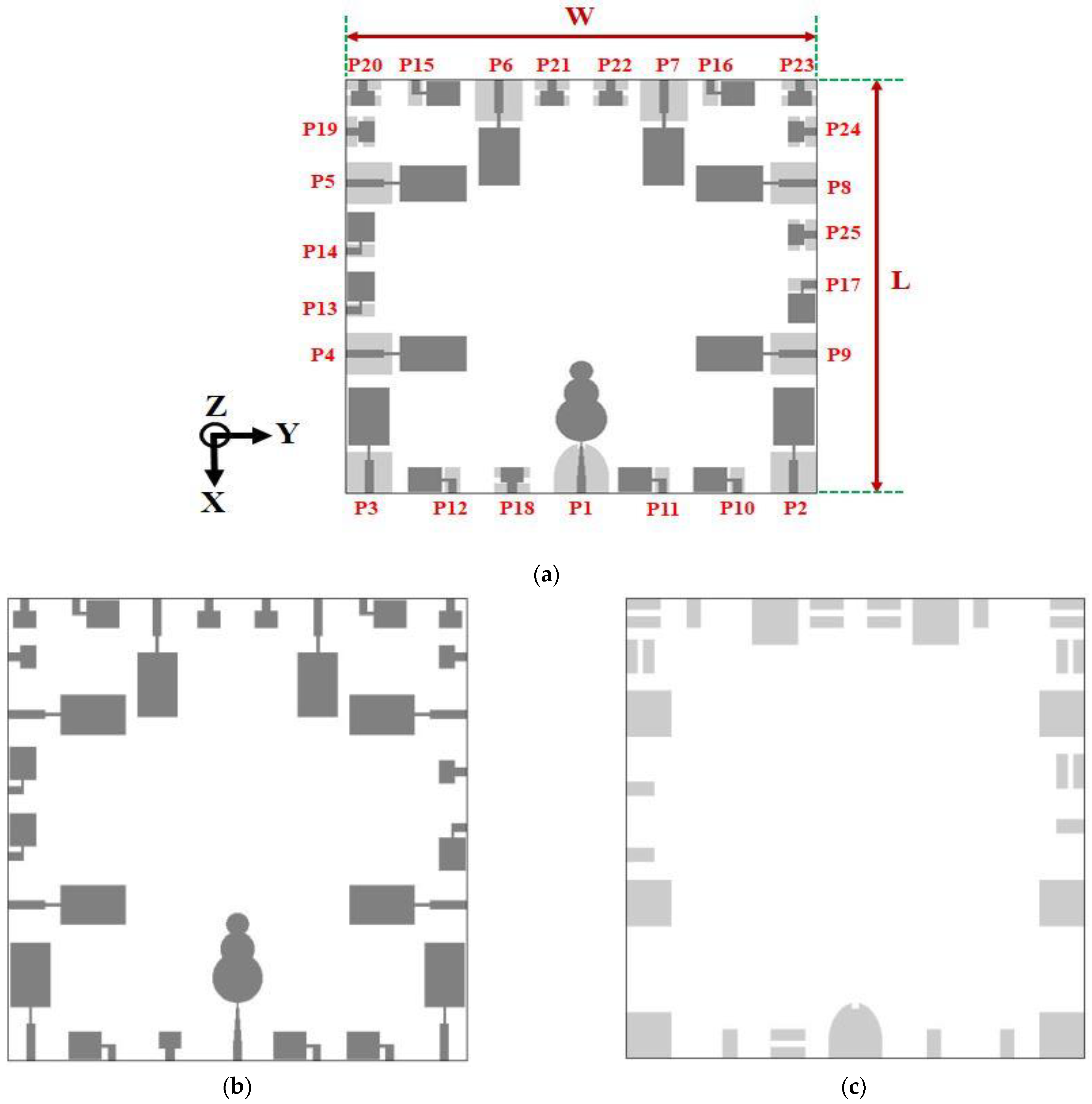

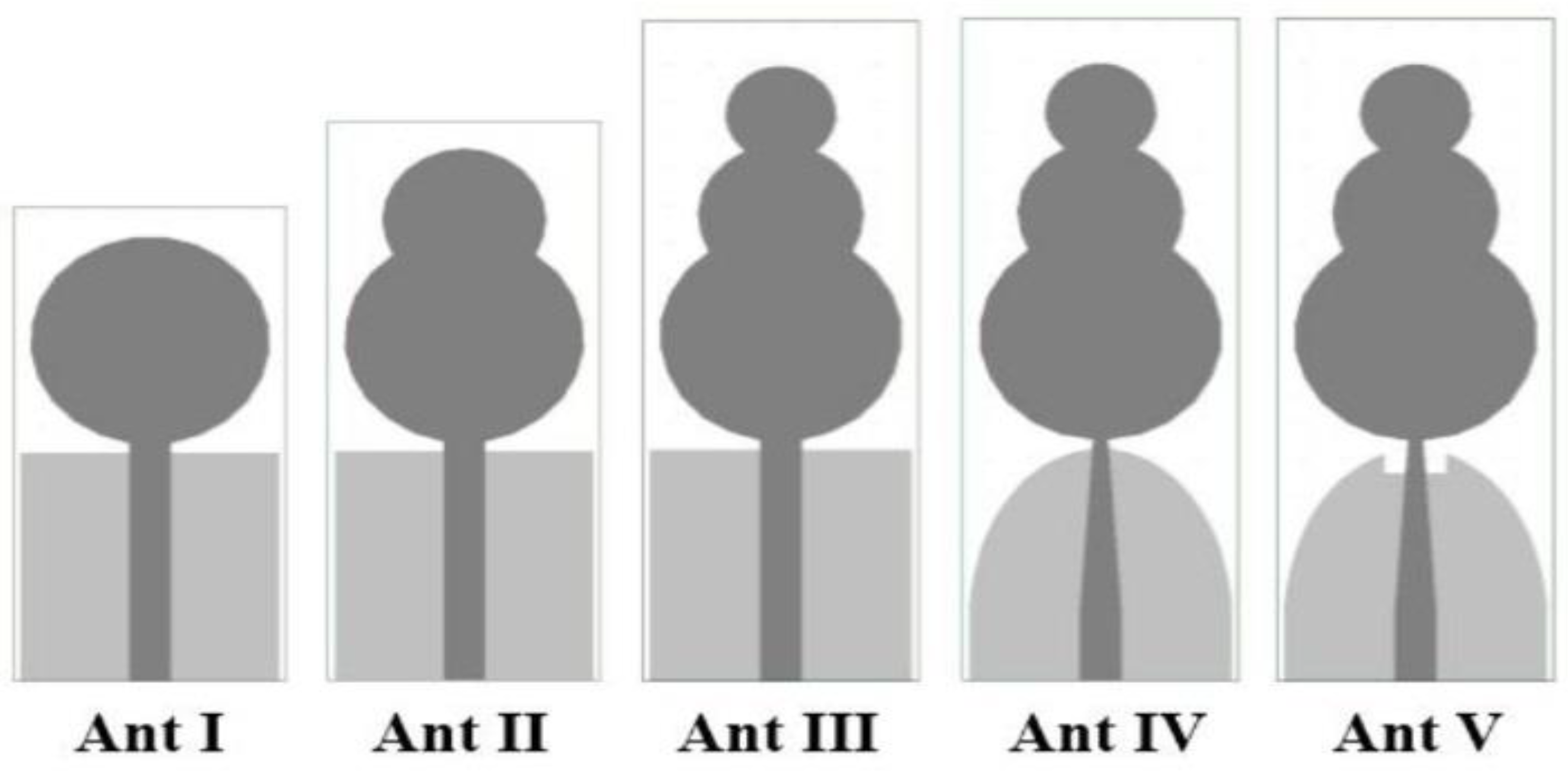
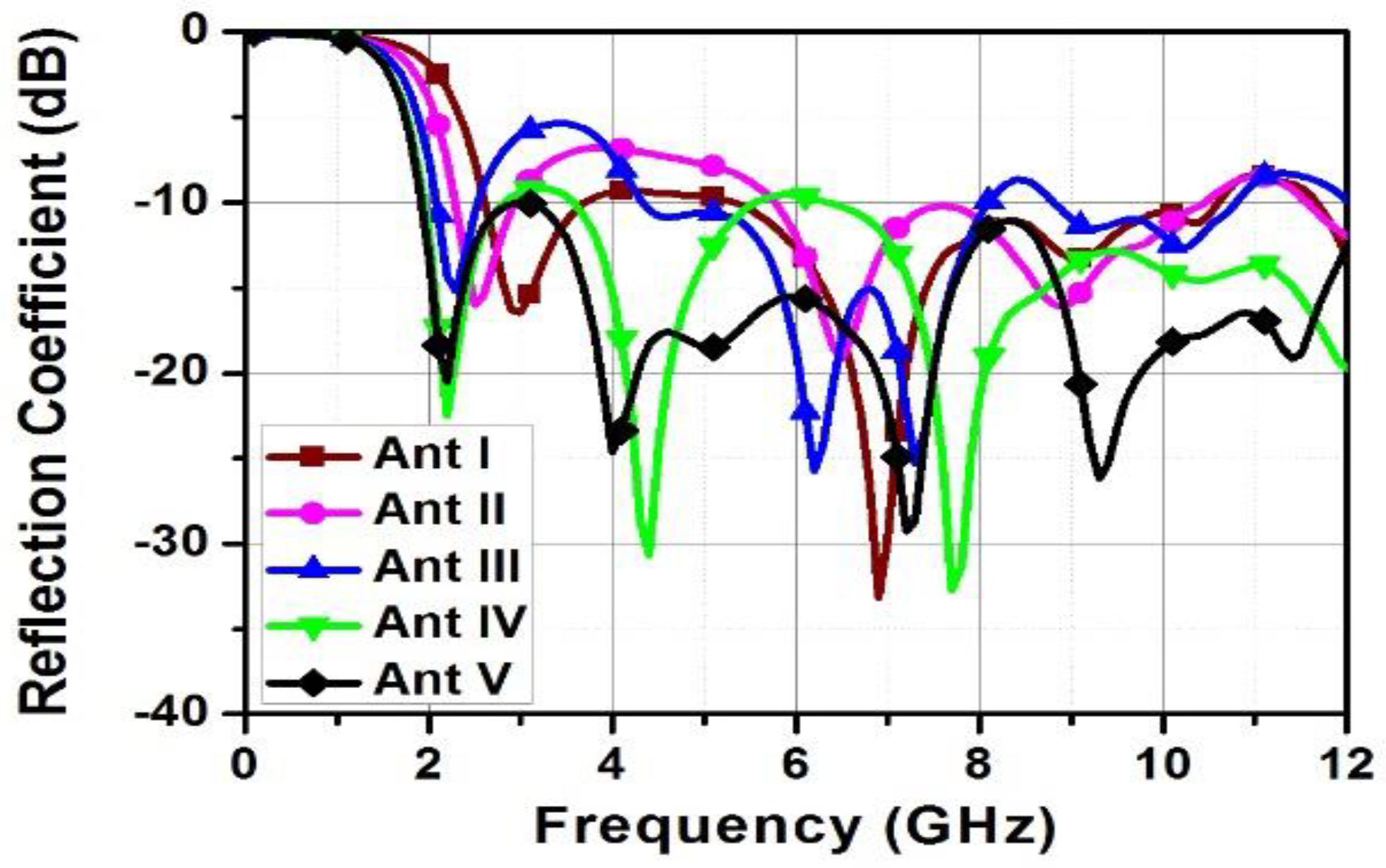

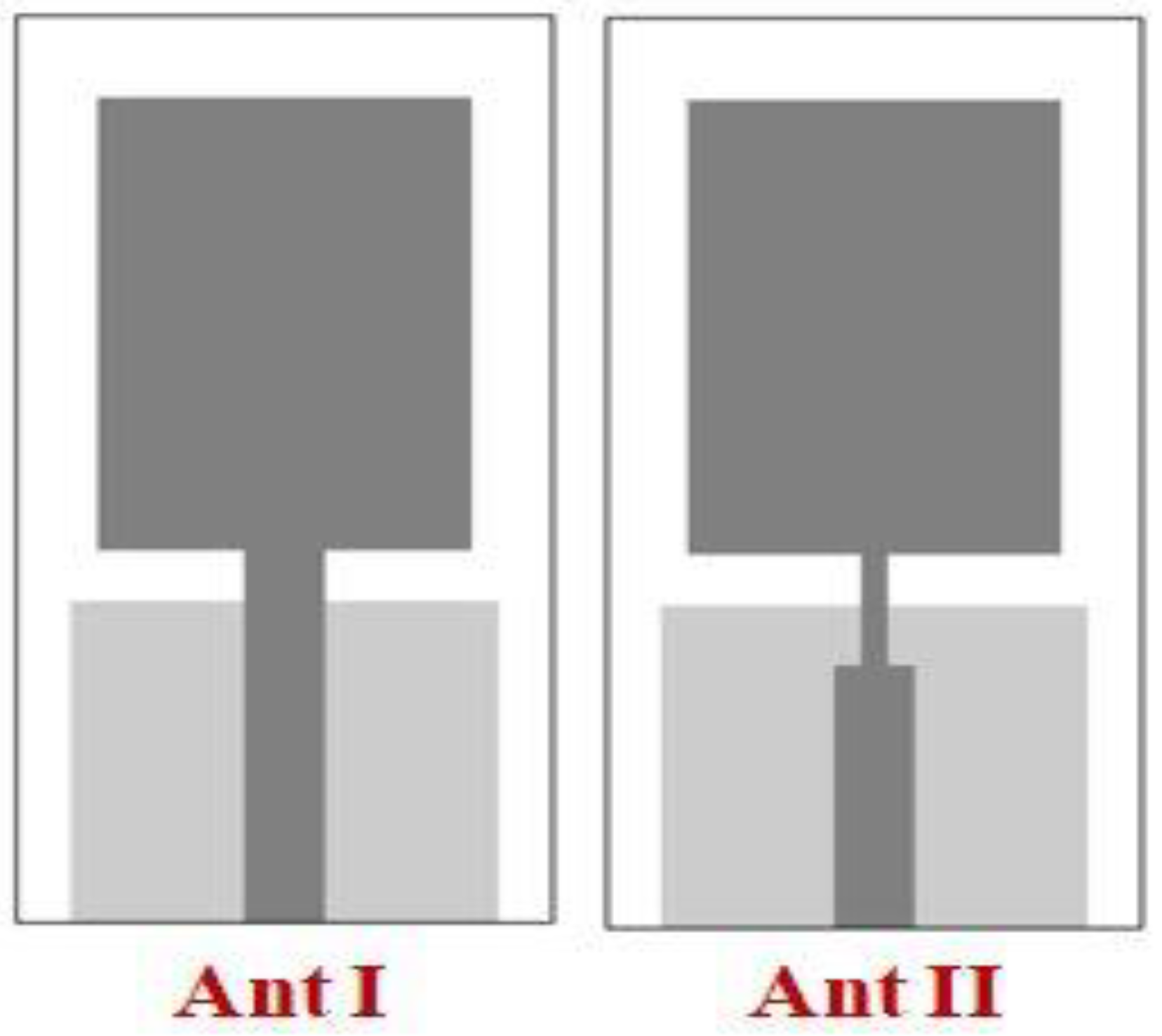




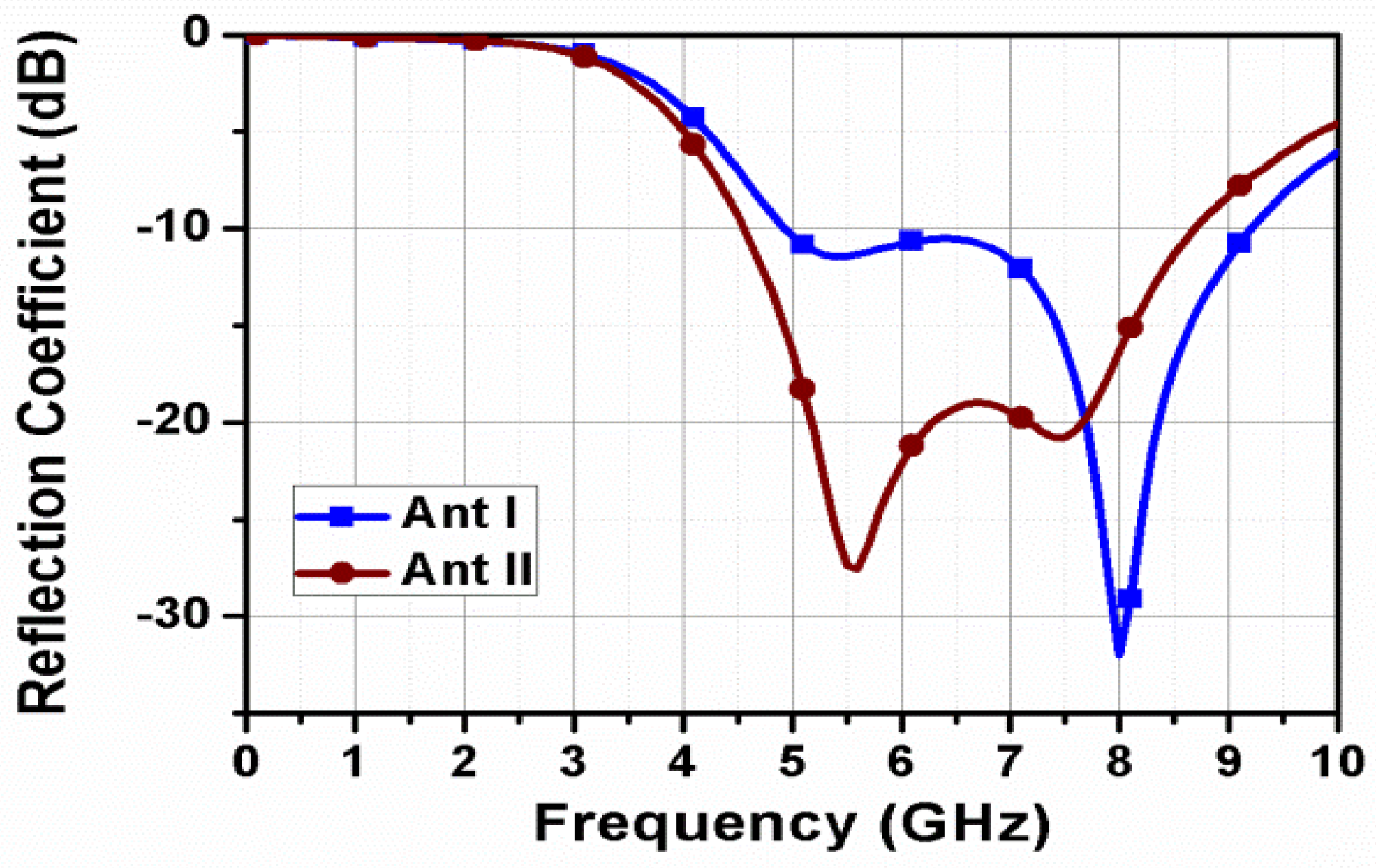

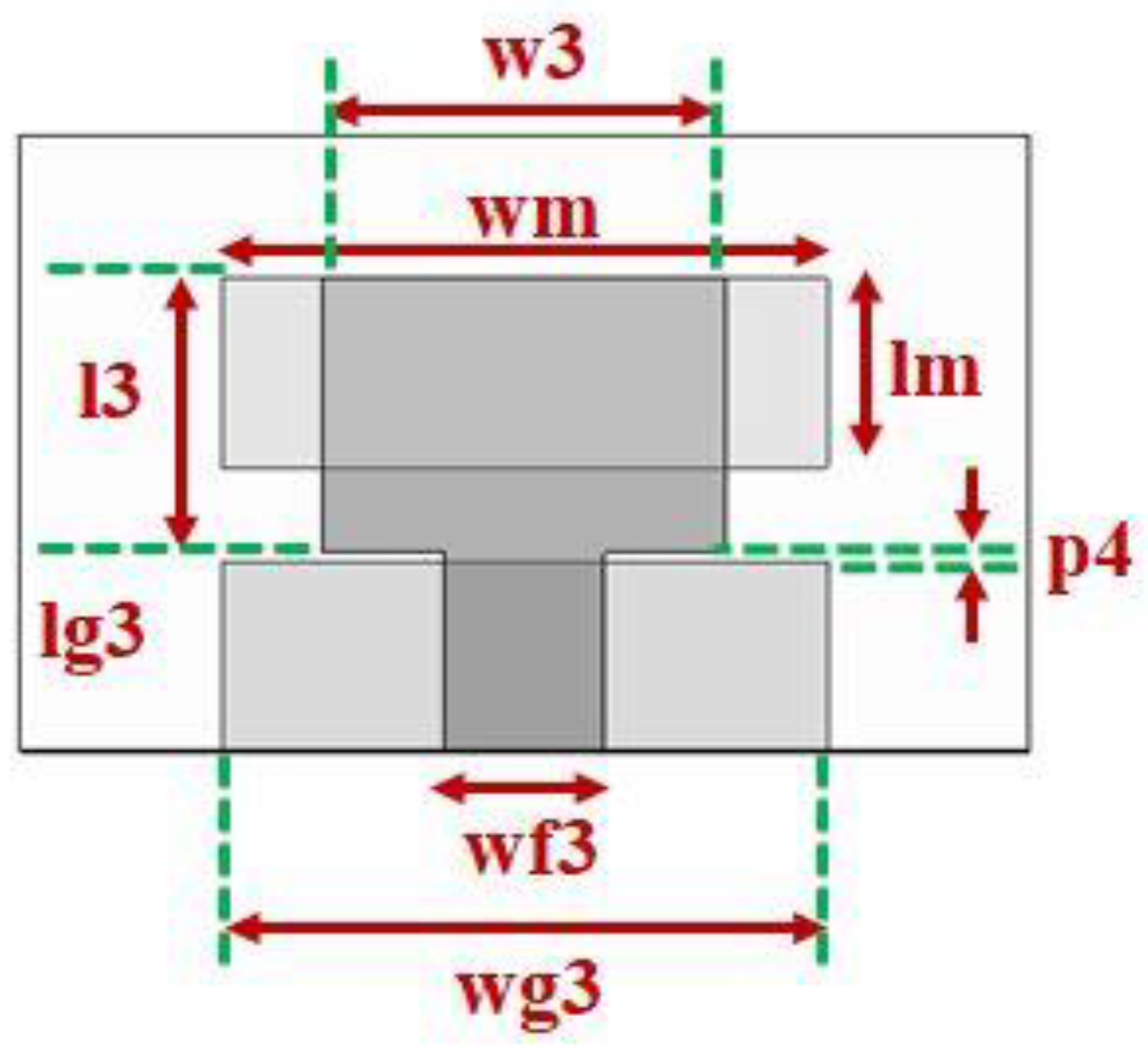



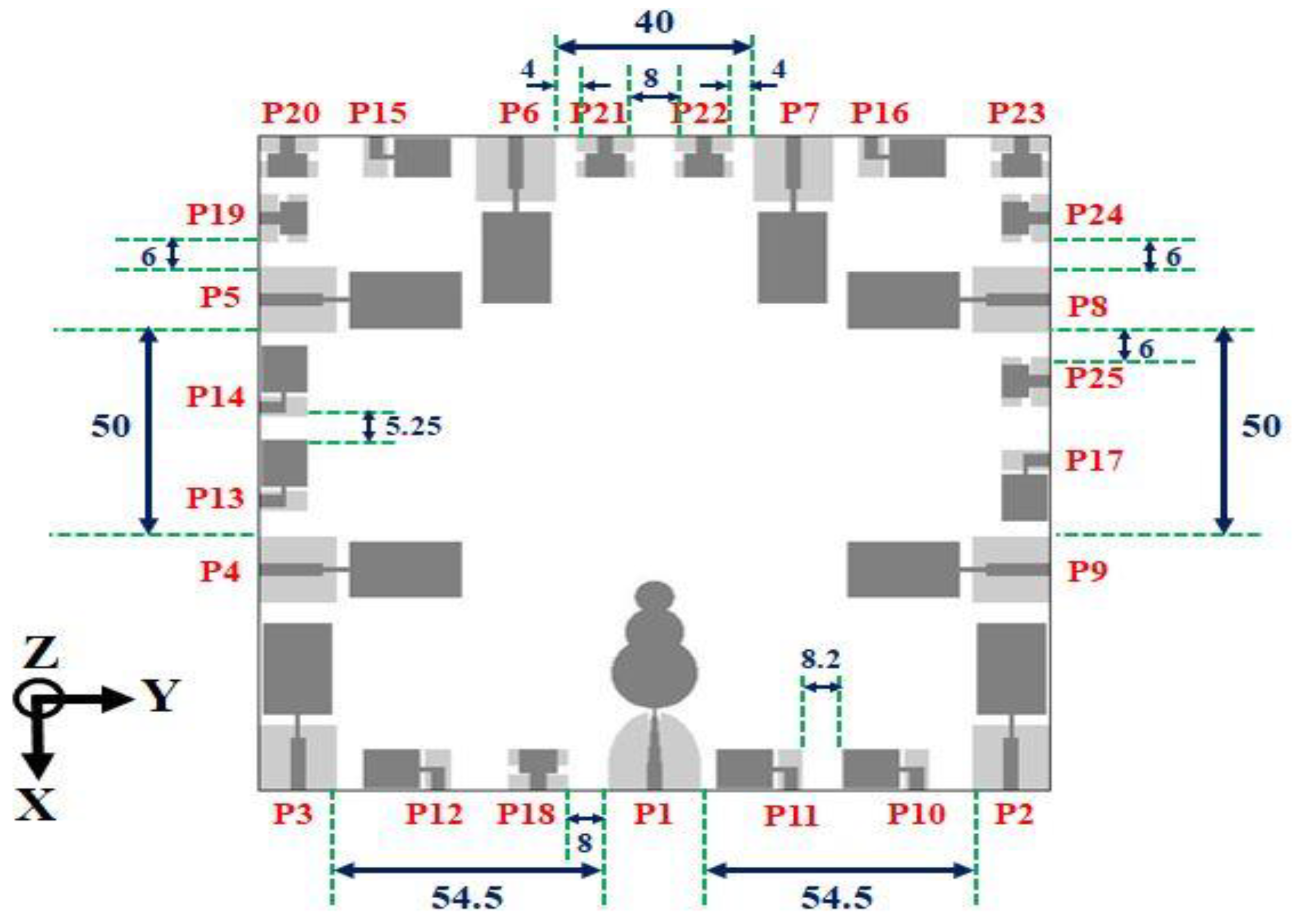
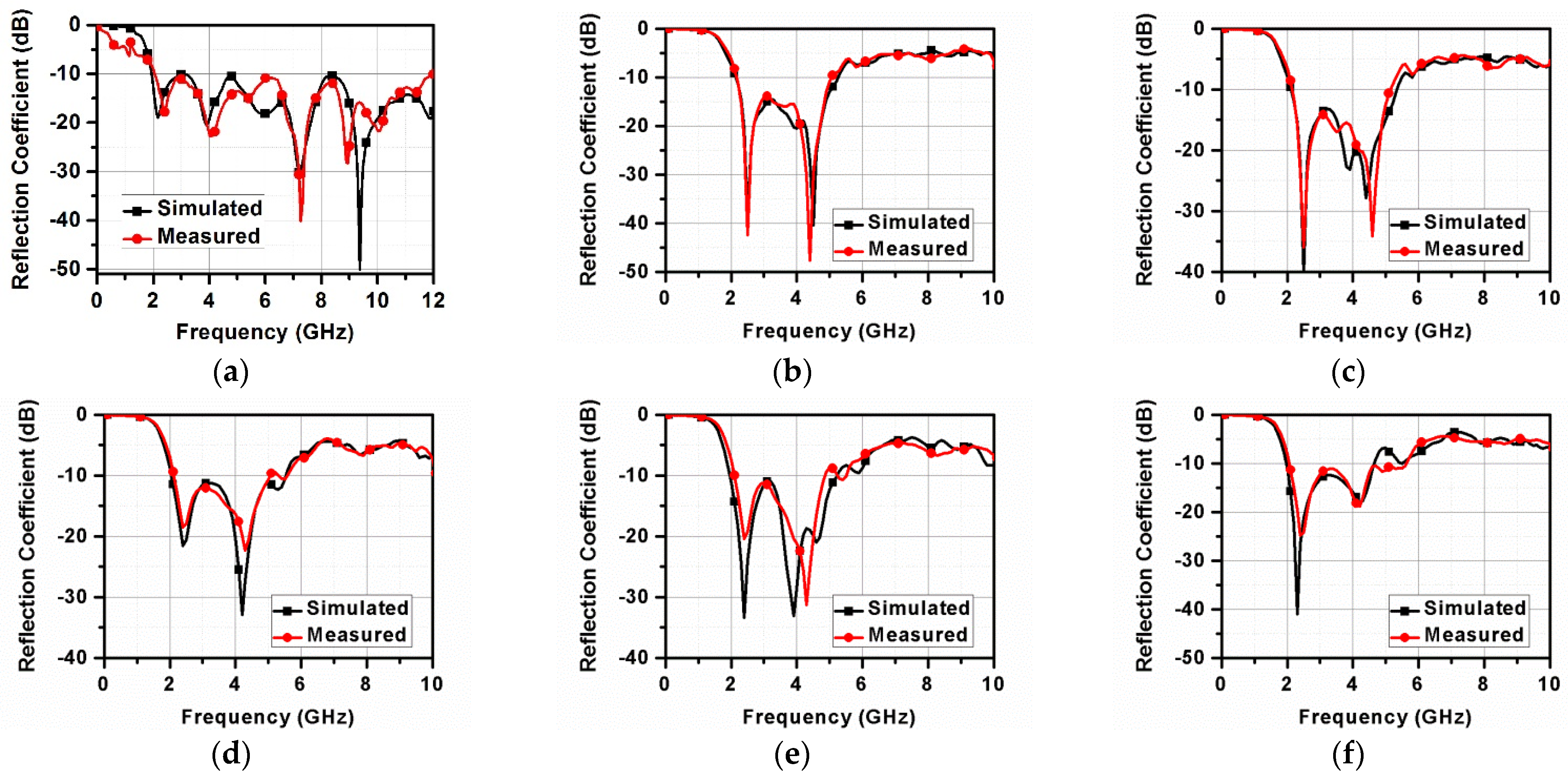

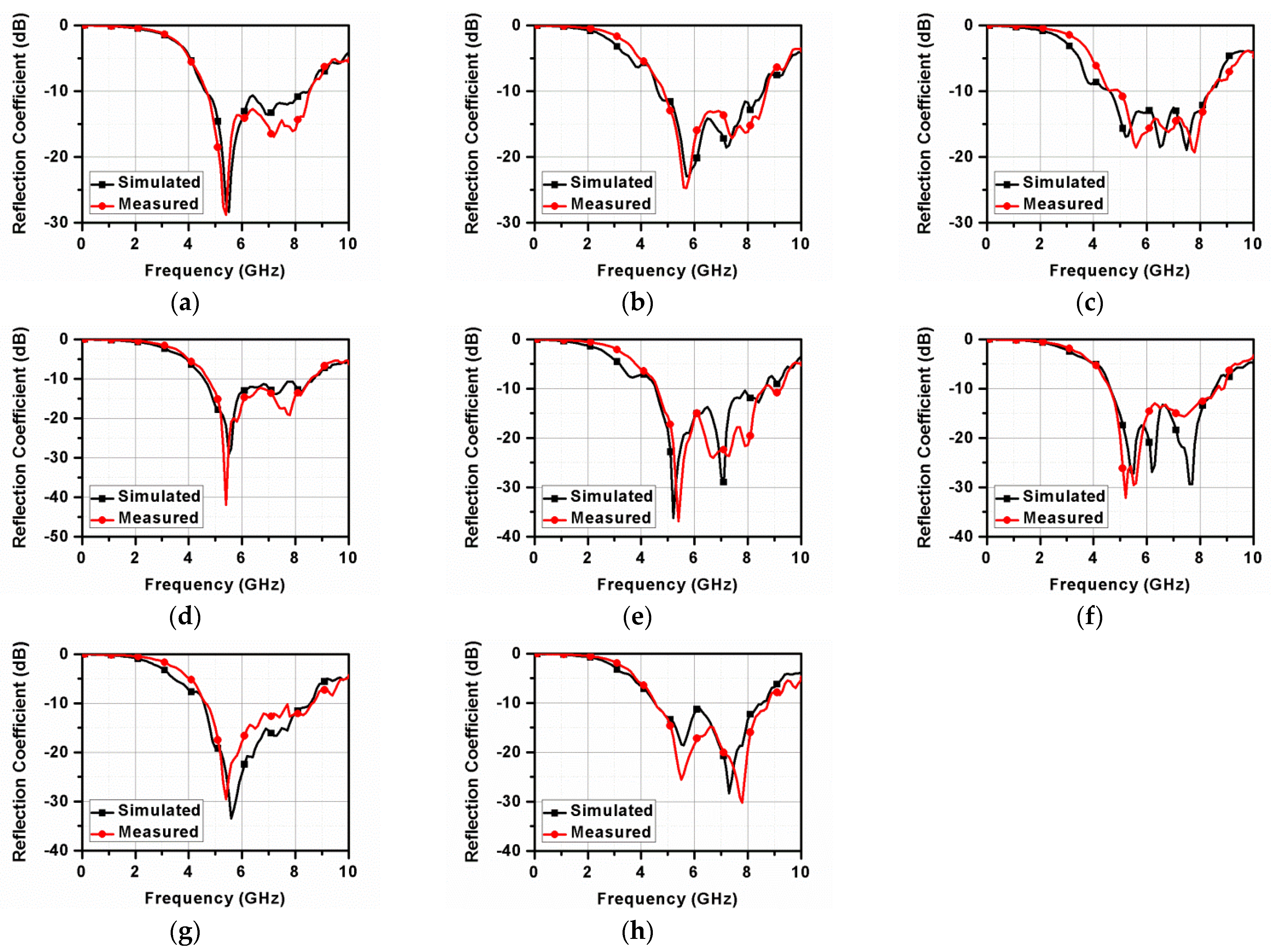


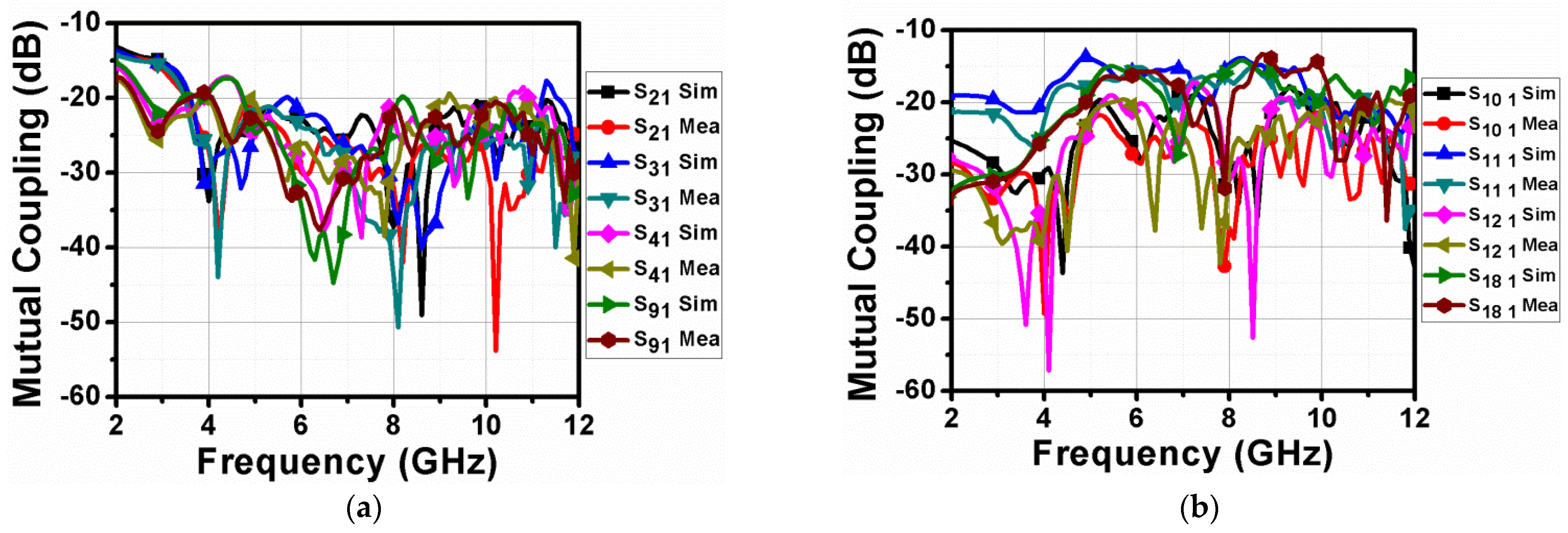
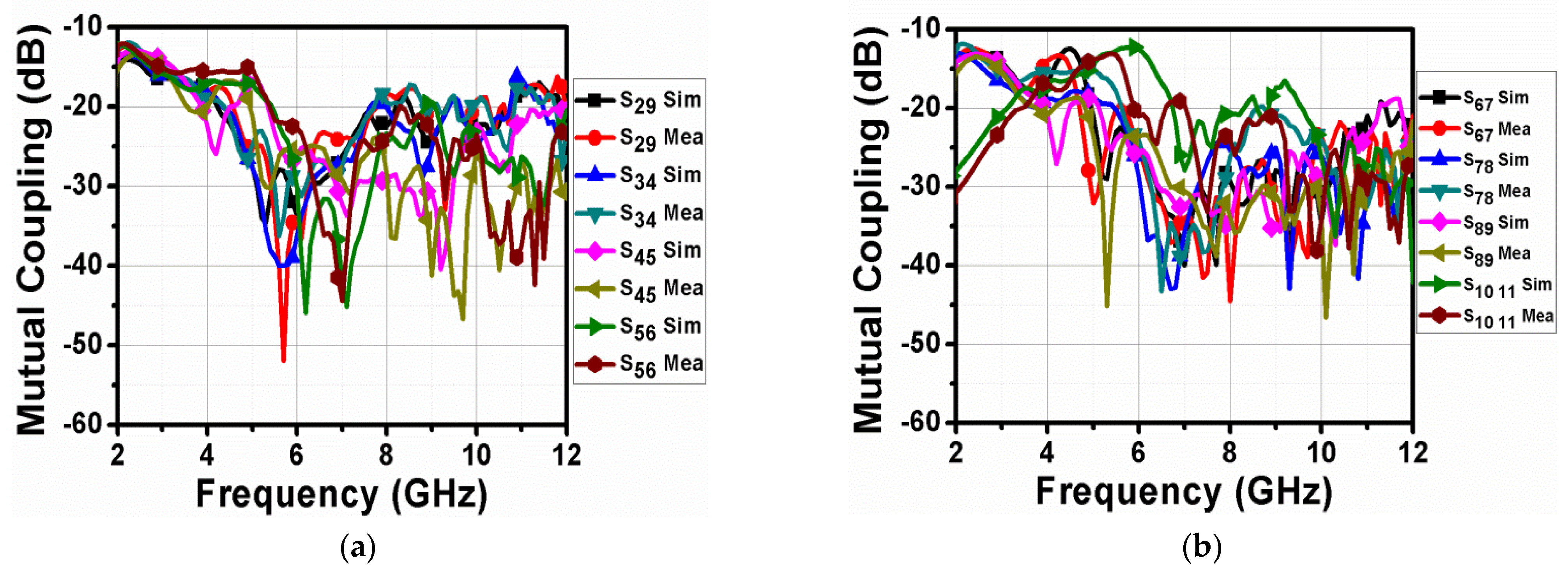

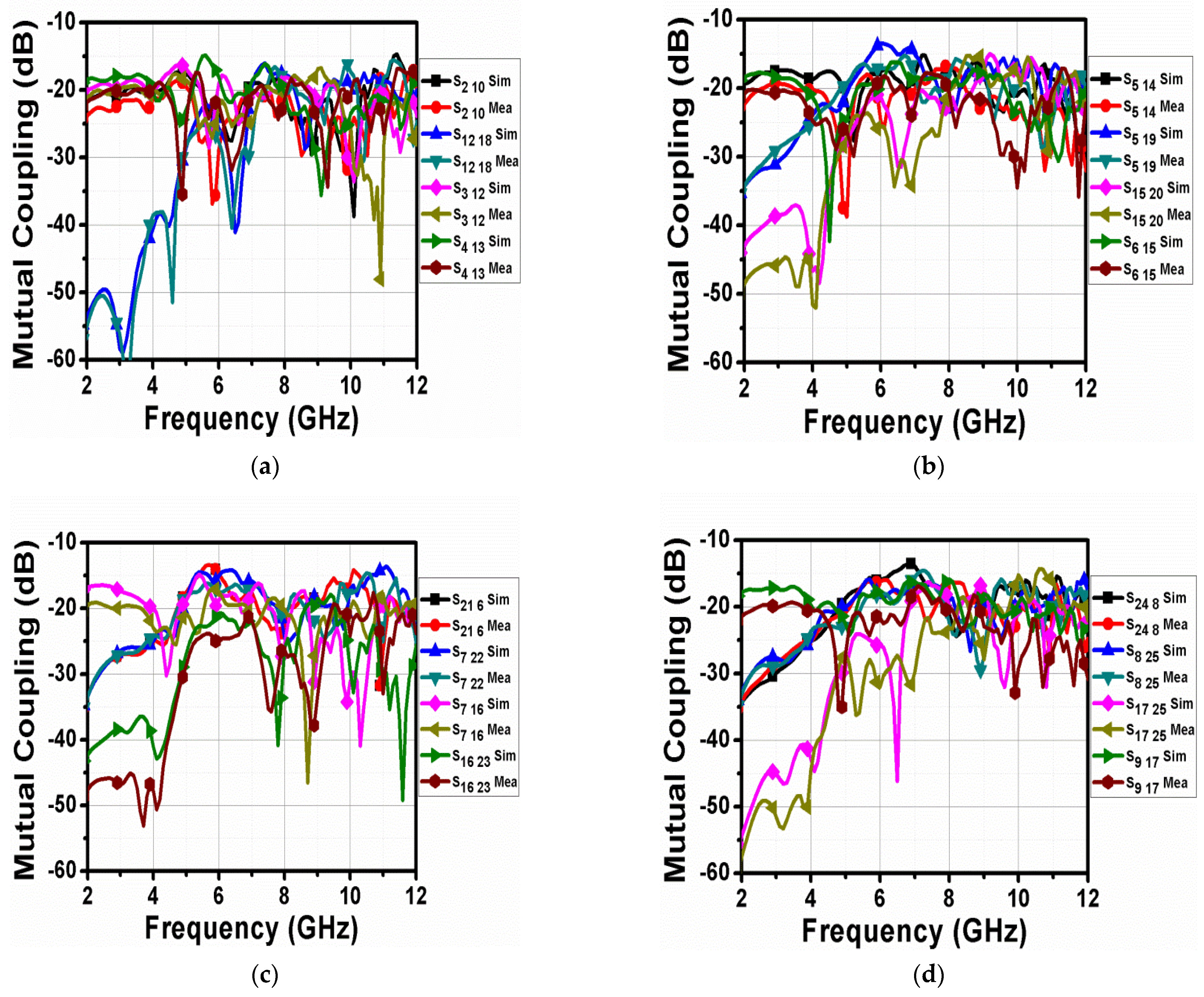
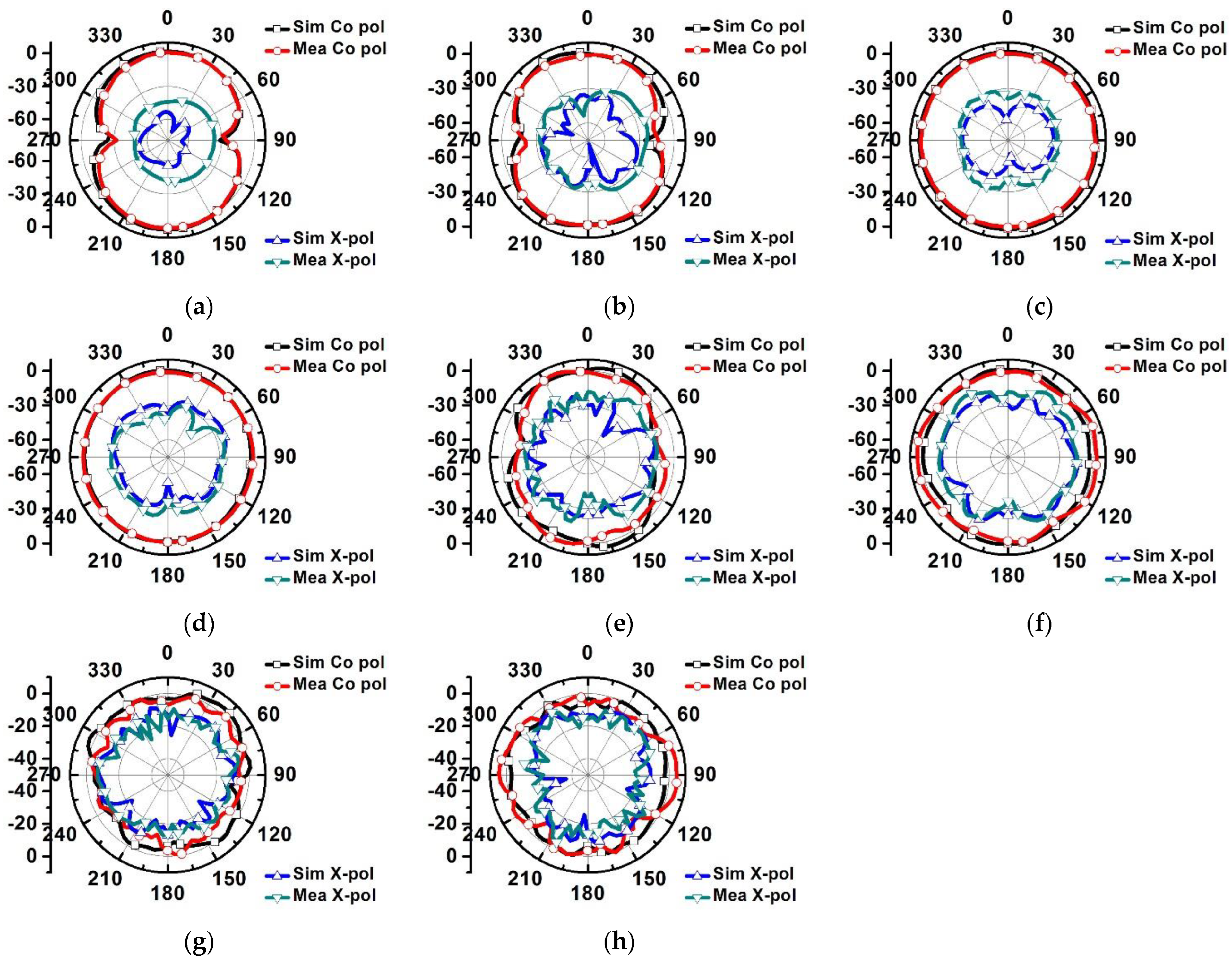
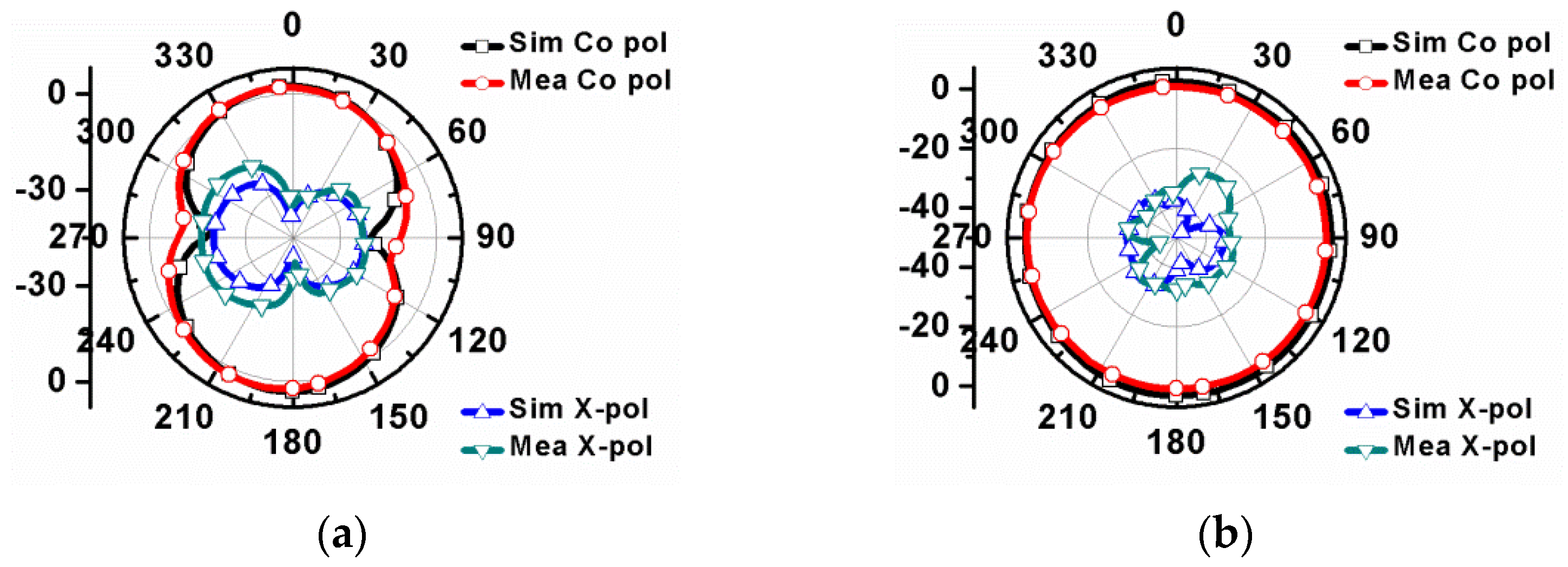


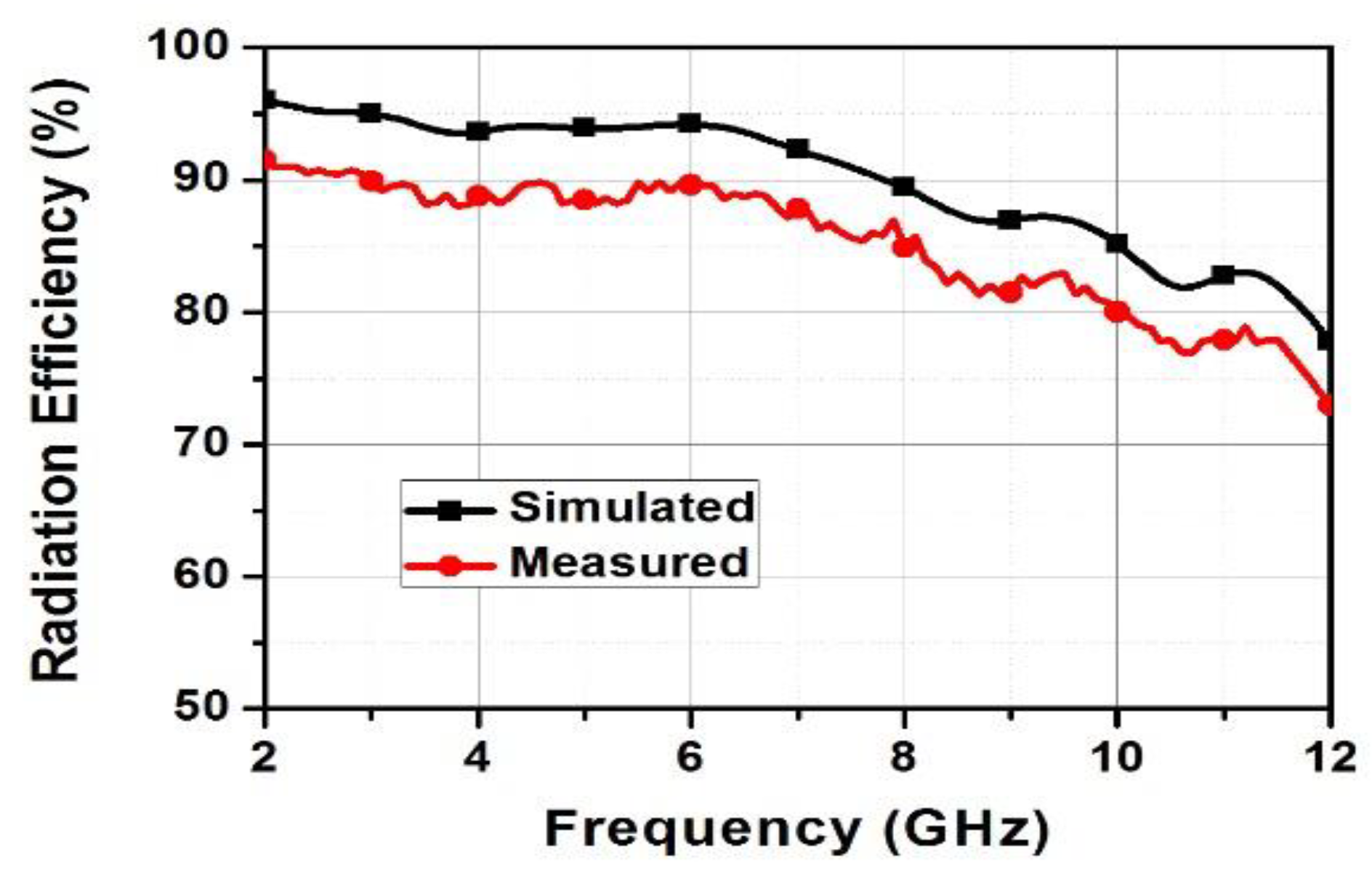
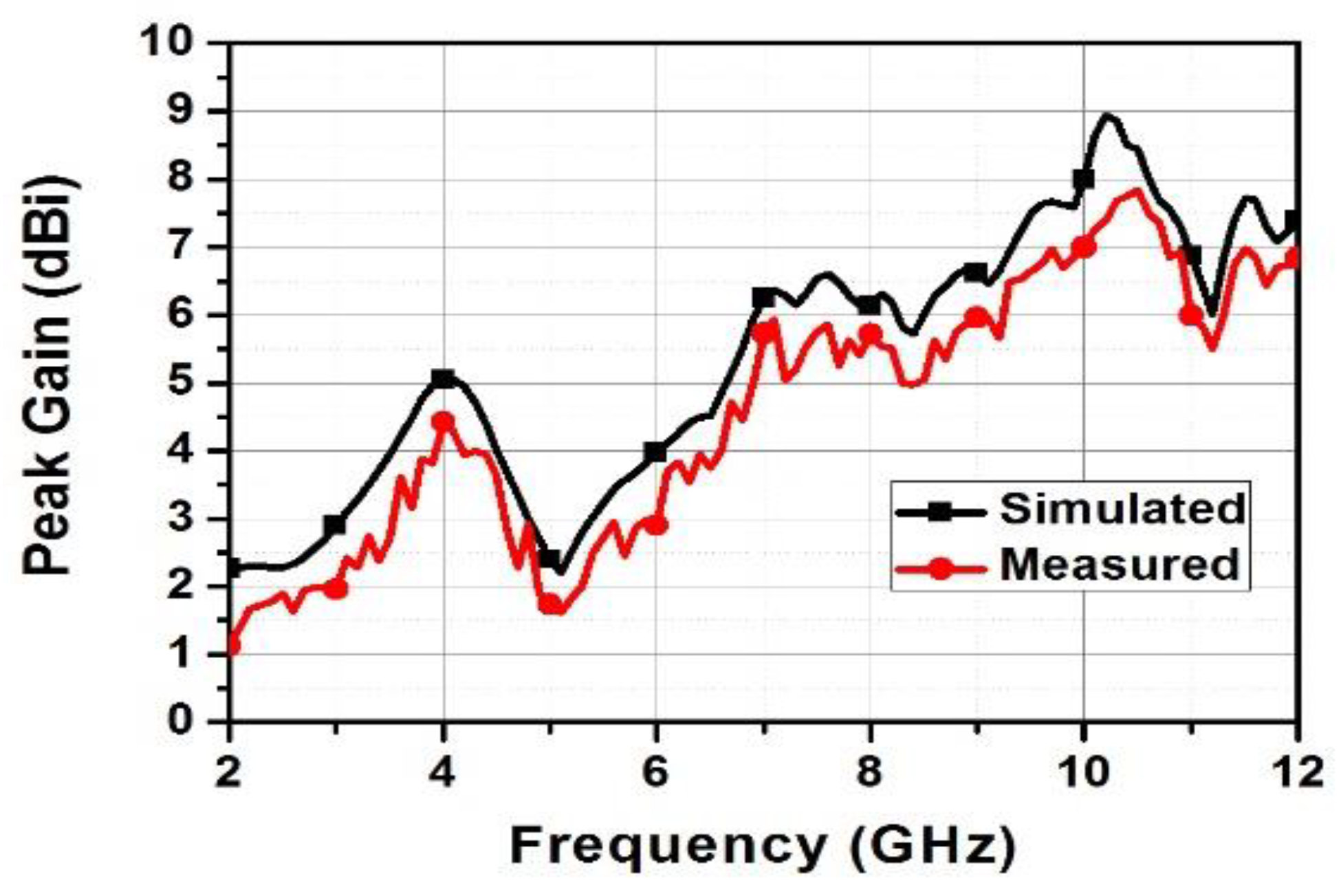
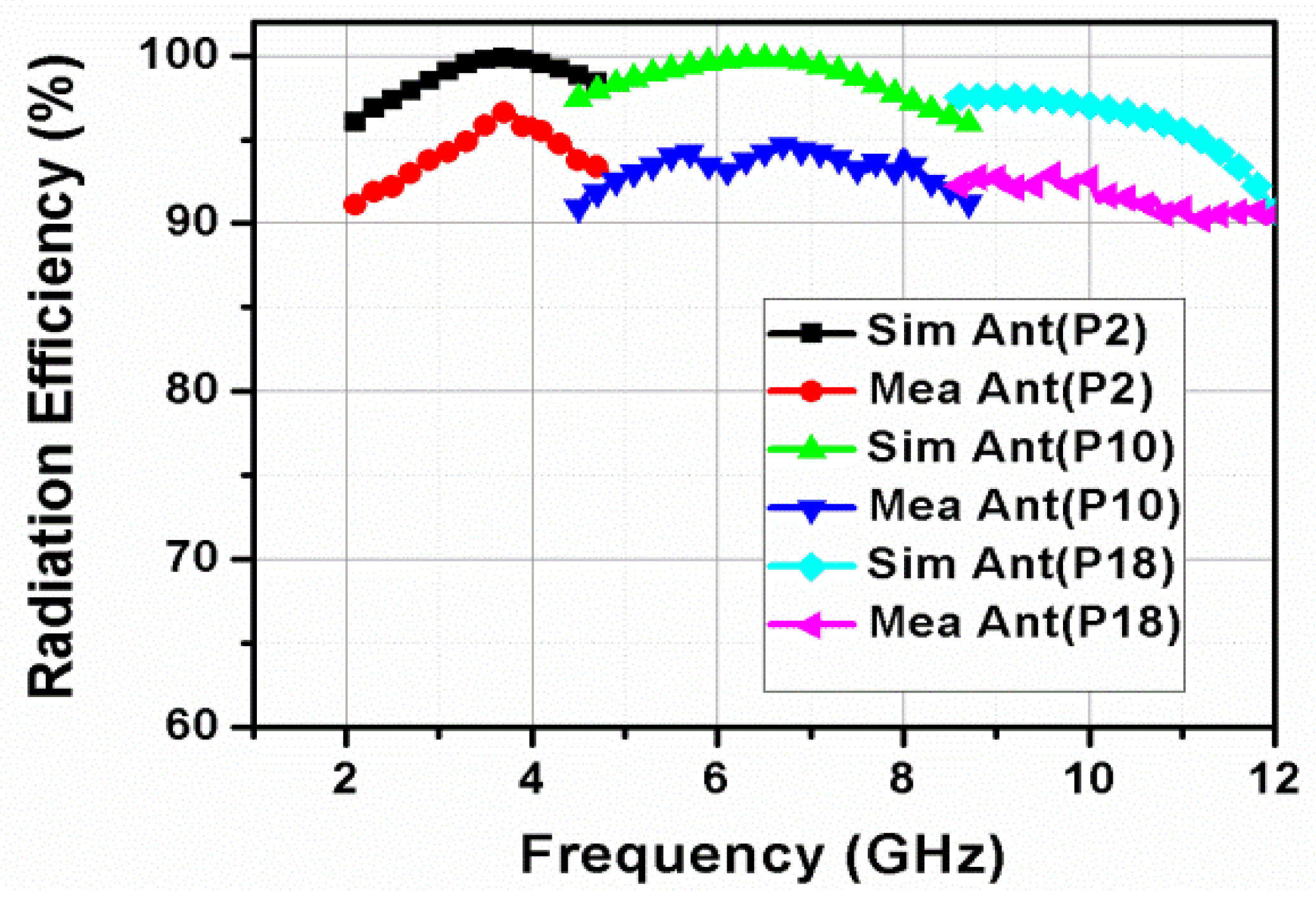
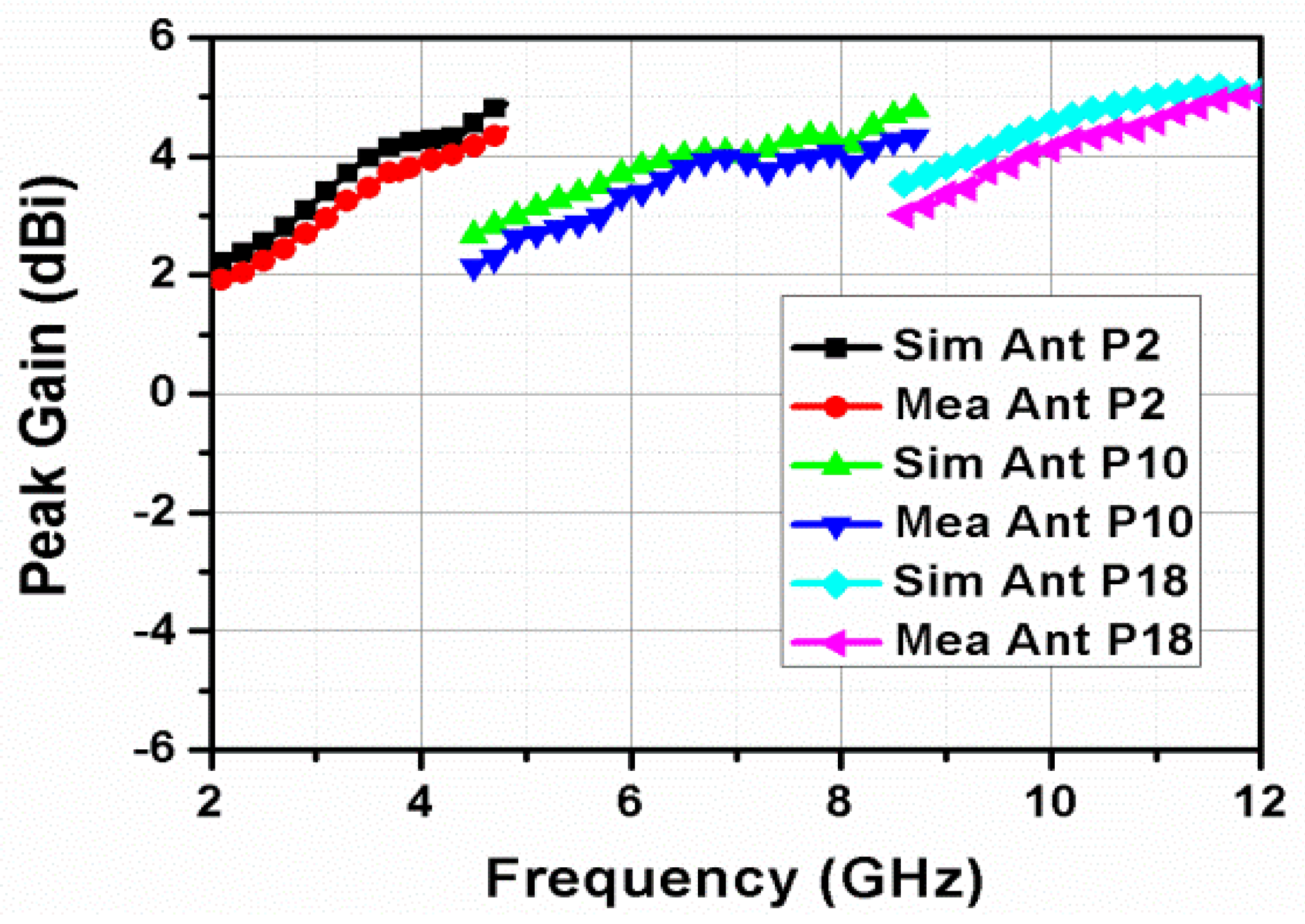
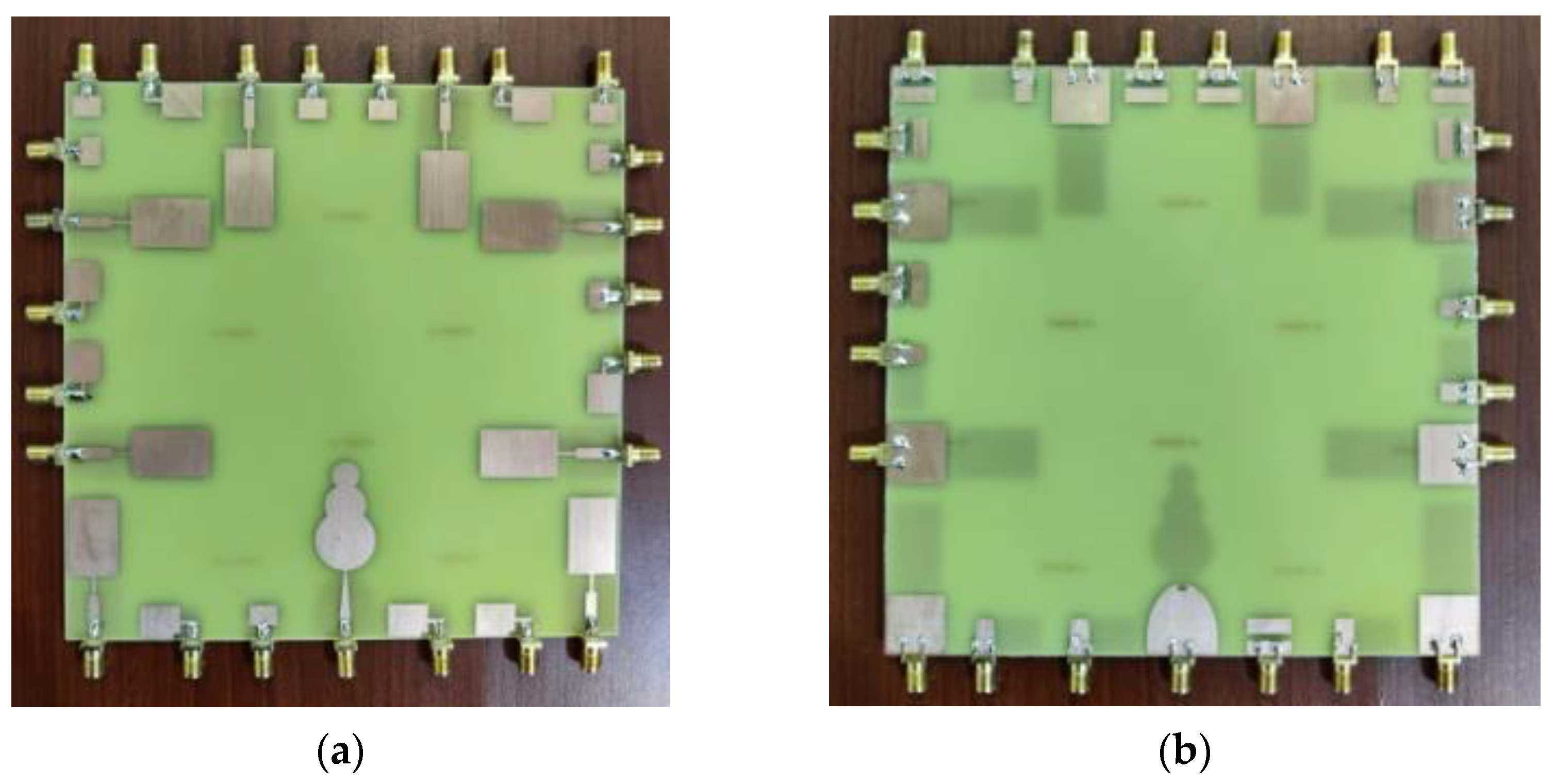

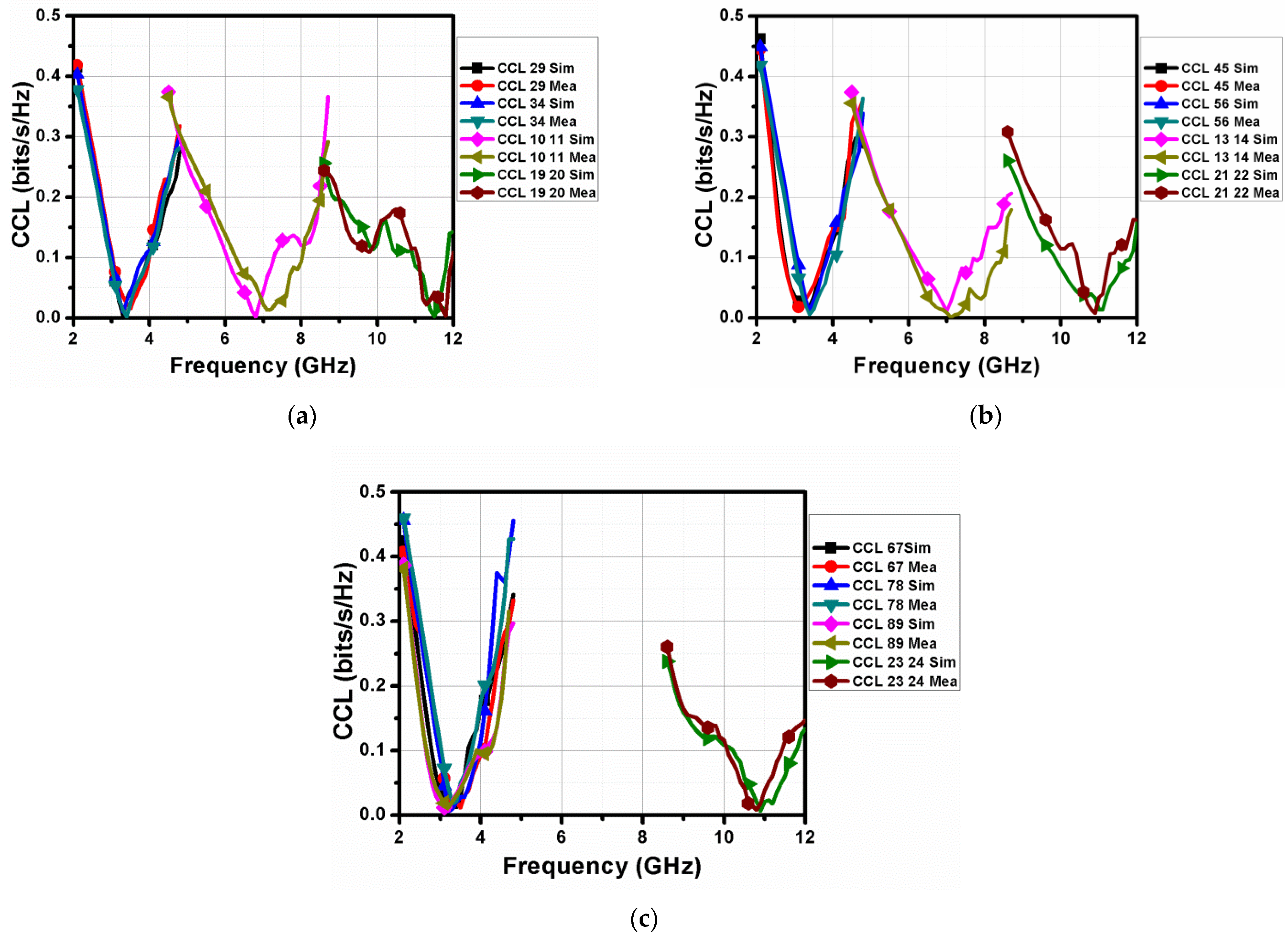

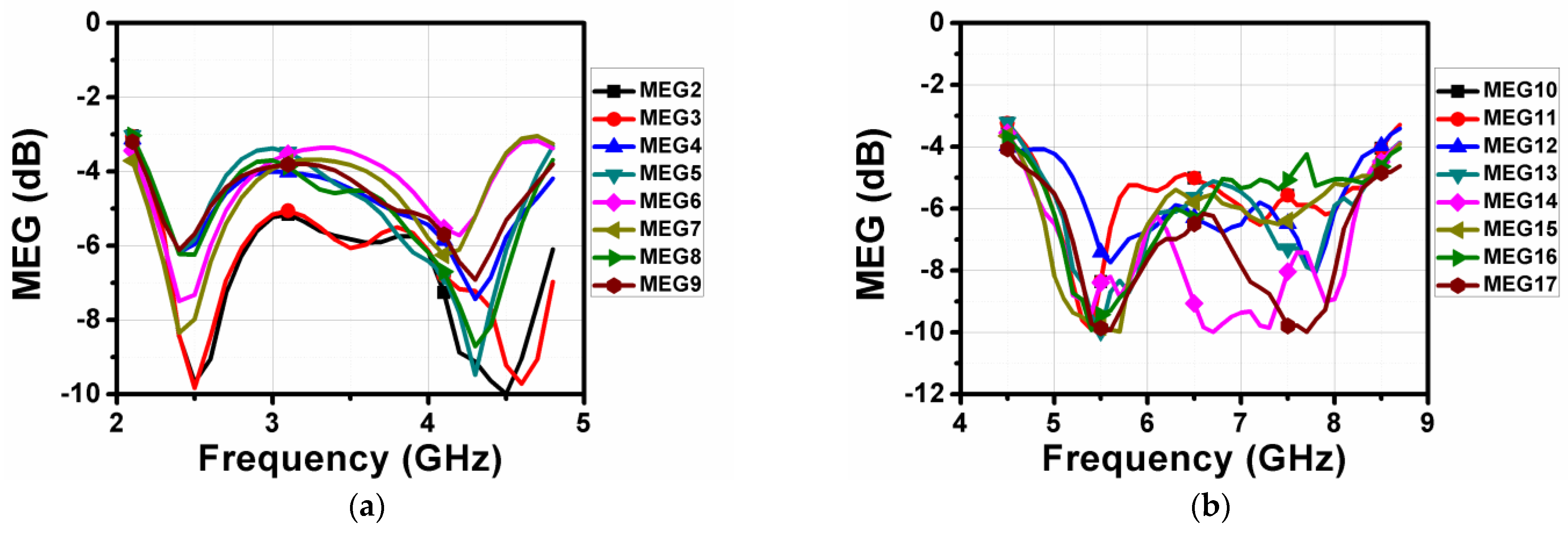

| Antenna | Usage | 10 dB Return Loss Bandwidth |
|---|---|---|
| Ant (P1) | Sensing | 2–12 GHz |
| Ant (P2) to Ant (P9) | Communication | 2.17–4.74 GHz |
| Ant (P10) to Ant (P17) | Communication | 4.57–8.62 GHz |
| Ant (P18) to Ant (P25) | Communication | 8.62–12 GHz |
| Parameter | Dimension (mm) | Parameter | Dimension (mm) |
|---|---|---|---|
| R1 | 8.78 | l1 | 22.5 |
| R2 | 5.28 | w1 | 14 |
| R3 | 4 | lg1 | 16 |
| p1 | 1.16 | wg1 | 16 |
| lg | 5 | ln1 | 5.5 |
| wg | 18.98 | wn1 | 1 |
| wf | 3 | p2 | 2.5 |
| ln | 1.57 | lw1 | 13 |
| wn | 4.5 | wf1 | 3 |
| p4 | 0.2 | l2 | 11.5 |
| wf3 | 3.2 | w2 | 9.5 |
| W | 160 | L | 160 |
| lg2 | 5 | w3 | 8 |
| wg2 | 10 | lm | 4 |
| wf2 | 3 | wm | 12 |
| wn2 | 1.1 | lg3 | 4 |
| p3 | 0.95 | wg3 | 12 |
| l3 | 5.8 | g1 | 1.16 |
| Ref. | Size (mm2) | Range of the Sensing Antenna (GHz) | Range Covered by Communication Antennas (GHz) | Min. Isolation (dB) | n-Element MIMO Antenna | Reconfiguration Mechanism |
|---|---|---|---|---|---|---|
| [1] | 50 × 100 | - | 1.42–2.27 | 12 | 2 | Varactor diodes |
| [2] | 60 × 120 | - | 3.2–3.9 | 10 | 4 | Varactor diodes |
| [3] | 109 × 109 | 2–5.7 | 2.5–4.2 | 15 | 4 | PIN and Varactor diodes |
| [4] | 60 × 40 | 2.2–7 | 2.3–6.3 | 18 | 2 | Varactor diodes |
| [5] | 100 × 120 | 2.3–5.5 | 2.5–4.2 | 15 | 4 | PIN and Varactor diodes |
| [6] | 60 × 120 | 1–4.5 | 0.9–2.6 | 12.5 | 2 | PIN and Varactor diodes |
| [7] | 65 × 120 | 0.72–3.44 | A few frequencies in 0.72–3.44 | 15.5 | 2 | PIN and Varactor diodes |
| [8] | 52.2 × 35 | 1.7–10.6 | 5.1–5.5, 6.6–7.2 and 9.7–10.2 | 15 | 2 | - |
| [9] | 50 × 110 | - | 1.73–2.28 and 2.45 | 10 | 2 | Varactor diodes |
| [10] | 110 × 70 | 2.45–5.3 | 2.5–3.6 | 12 | 4 | Varactor diodes |
| [11] | 152 × 126 | 2.4–6 | 5.8–6.3 | 20 | 4 | PIN diodes |
| [12] | 24 × 25 | - | 2.4, 3.5, 5.25 | 25 | 2 | PIN diodes |
| This work | 160 × 160 | 2–12 | All frequencies in 2.17–12 | 12 | 8 | - |
Disclaimer/Publisher’s Note: The statements, opinions and data contained in all publications are solely those of the individual author(s) and contributor(s) and not of MDPI and/or the editor(s). MDPI and/or the editor(s) disclaim responsibility for any injury to people or property resulting from any ideas, methods, instructions or products referred to in the content. |
© 2023 by the authors. Licensee MDPI, Basel, Switzerland. This article is an open access article distributed under the terms and conditions of the Creative Commons Attribution (CC BY) license (https://creativecommons.org/licenses/by/4.0/).
Share and Cite
Srikar, D.; Nella, A.; Mamidi, R.; Babu, A.; Das, S.; Lavadiya, S.; Algarni, A.D.; El-Shafai, W. A Novel Integrated UWB Sensing and 8-Element MIMO Communication Cognitive Radio Antenna System. Electronics 2023, 12, 330. https://doi.org/10.3390/electronics12020330
Srikar D, Nella A, Mamidi R, Babu A, Das S, Lavadiya S, Algarni AD, El-Shafai W. A Novel Integrated UWB Sensing and 8-Element MIMO Communication Cognitive Radio Antenna System. Electronics. 2023; 12(2):330. https://doi.org/10.3390/electronics12020330
Chicago/Turabian StyleSrikar, D, Anveshkumar Nella, Ranjith Mamidi, Ashok Babu, Sudipta Das, Sunil Lavadiya, Abeer D. Algarni, and Walid El-Shafai. 2023. "A Novel Integrated UWB Sensing and 8-Element MIMO Communication Cognitive Radio Antenna System" Electronics 12, no. 2: 330. https://doi.org/10.3390/electronics12020330
APA StyleSrikar, D., Nella, A., Mamidi, R., Babu, A., Das, S., Lavadiya, S., Algarni, A. D., & El-Shafai, W. (2023). A Novel Integrated UWB Sensing and 8-Element MIMO Communication Cognitive Radio Antenna System. Electronics, 12(2), 330. https://doi.org/10.3390/electronics12020330









